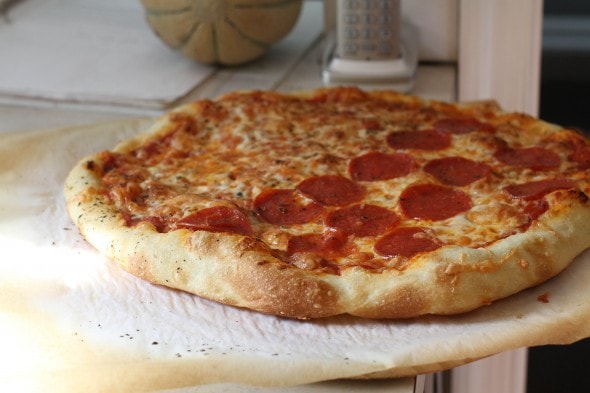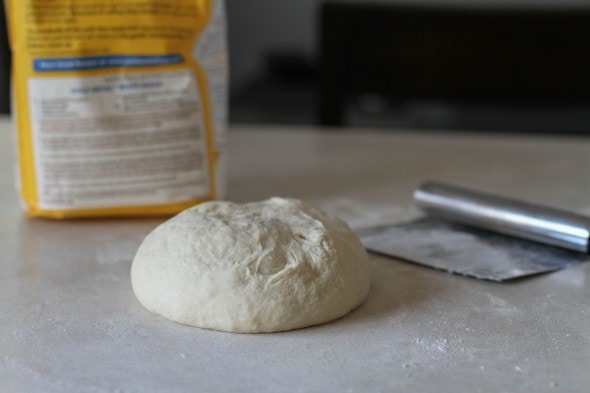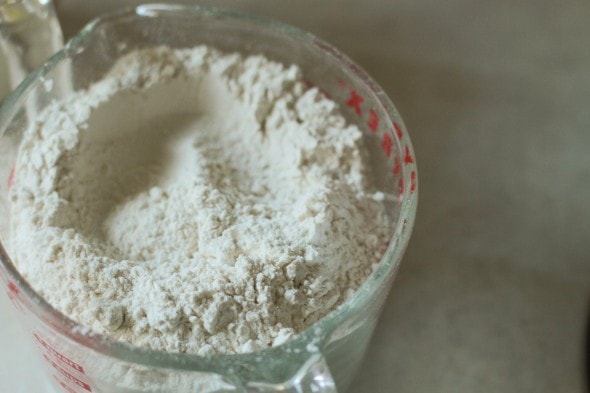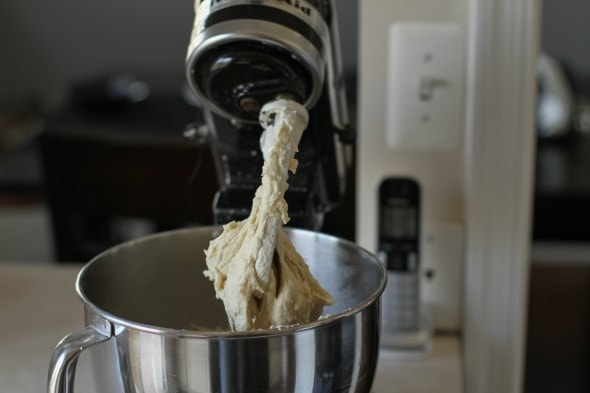Good Tuesday to all of you! Sorry for the radio silence yesterday. Real life got in the way of my blogging time this weekend. 😉 So, we have a Tuesday Q&A to make up for that.
Hi Kristen!
I have tried making homemade pizza a handful of times using your crust recipe, and every time the middle of my dough comes out soggy. It’s so frustrating! Have you ever had this problem before, and do you have any tips on what I can do to make better (not soggy!) pizza?

I bake it on a preheated stone, I’m not putting loads of toppings on, I’ve tried par-baking the crust before adding toppings, and none of that has helped to fix this issue.
Thanks!
Amanda
After Amanda sent me this question, we emailed back and forth a bit, since it sounded to me like she was already doing all the things I’d suggest. I needed more info!
Since I was a bit stumped, I asked Amanda about the location of the doughiness and also about the texture of the dough. She said the doughiness is all over the pizza, and that her dough is fairly firm, and that it doesn’t rise much.
And then I got un-stumped.
Bread dough just does not function well when it’s really stiff. Yeast bubbles are quite powerful, but they have a terrible time trying to lift a stiff, heavy dough.
So, a stiff dough doesn’t rise well, and then because it’s dense and heavy, it doesn’t bake properly either (the outside will burn before the inside gets cooked all the way.)

Sometimes, the fix is as simple as using less flour. Regardless of what the recipe says, you should only use enough flour to make your dough soft and stretchy. It should bounce back when you poke it with a finger, and if you shape it into a ball and place it on the counter, it should immediately relax into a slightly flattened ball shape.
You have to go by feel a bit here, because the amount of flour necessary for this texture varies due to differences in climate, season, and also variances in flour.
Which brings me to my next tip: all flour is not created equal.
In my experience, cheap store-brand flour tends to make a heavy dough. If I make a dough with 4 cups of Gold Medal unbleached, the dough is far softer than dough made with 4 cups of store brand flour.
So, if you’re using cheap flour, it’s very easy to get your dough too stiff, even when you’re using the amount of flour called for in the recipe.

For most bread-baking, I like Gold Medal unbleached, but for pizza dough, King Arthur bread flour really cannot be beat.
The taste and texture of pizza dough made with King Arthur bread flour is amazing, even when compared to Gold Medal pizza dough.

So, my two suggestions for Amanda are:
1- Use less flour
2- Make sure you are using super-awesome King Arthur bread flour
I’m pretty darn confident that those two suggestions will take the pizza from doughy to fantastic.
Do report back to us, Amanda!
(I’m not affiliated with King Arthur. I just happen to dig their bread flour.)

EmilyHG
Monday 4th of April 2016
Thank you for saying use less flour. I usually make the pizza dough recipe on the pizza yeast packet, and I made it the other night with less flour and it was SO much better. Thanks!!
Kristen
Monday 4th of April 2016
YAY!! It makes me so so happy to hear that.
Rod
Wednesday 23rd of March 2016
For consistent results, weigh the ingredients. You may have to experiment a bit to get optimal hydration. Hydration is the water/flour ratio, by weight. Something in the range of 0.60 to 0.65 would be about right. Once you get the numbers down, good results are just about locked in.
Flours make a difference. Using a high-gluten (hard) bread flour is best for pizza crusts, but not absolutely required. Softer all-purpose flours will work fine, but stay away from low-gluten flours (e.g., White Lily). Those are for cakes and biscuits. The problem with some of the store brands is that you don't know what you are getting.
Knead generously. It is hard to over-knead. Do it by hand to learn the feel of the dough. It's good exercise! Use the "window" test to check gluten development. (The dough should stretch thin enough to see through without tearing. Note: If you use whole wheat flour, the bran will make it tear more easily, so compensate a little.)
Letting the dough rest, as stated, is very good. In addition to the gluten relaxing, the longer it rests, the more the yeast develops the complex flavors that add the extra 'yum' to the crust. An hour is the minimum.
Baking on a pre-heated stone instead of in a pan let's the moisture escape from the bottom. High-moisture toppings (onions, peppers, mushrooms, okra [Yes, okra! Try it.]) release a lot of water in baking. If they are covered with a blanket of cheese, the only route of escape for the moisture is through the crust. Even on a stone the crust can be wet. If you love the veggies, back off on the cheese so that the moisture can vent out the top.
Mara
Wednesday 23rd of March 2016
Another thing to add is the thinner she can make the dough the better. I'll make it paper thin sometimes. If you can't make it thin your dough isn't ready yet. I use a recipe that gets it ready in half an hour or less (yes, the key is bread flour). So the thinner the dough and the hotter the oven the better the pizza.
chris
Tuesday 22nd of March 2016
My kids are gluten-free and the KA gluten free multipurpose flour is the best gf flour blend out there. I have never attempted from scratch bread or pizza dough with, though. They have separate pizza and bread mixes that I avoid due to use of xanthan gum. Yuck. So...hmm...I need to experiment because our current gf pizza mux is fine but veers either too chewy or too crispy. Meh.
Ali
Wednesday 23rd of March 2016
My GF pizza crust improved dramatically when I started adding cooked quinoa to the mix - about 1:3 quinoa to flour by volume. The quinoa grains dissolve into the dough when you bake it, which gives you the extra protein to make it stretchy. I was totally skeptical, but tried it and will never make GF pizza crust any other way!
Janknitz
Tuesday 22nd of March 2016
I actually prefer Gold Meadow all purpose to King Arthur for pizza because I find the dough is a bit softer and easier to stretch with LESS protein. I also learned to weigh my ingredients rather than measure--that helps account for the difference in humidity, IMHO and provides more consistent results. (Plus you don't have a dirty measuring cup to clean!).
I have learned over the years to deal with very wet doughs, so I rarely add any flour when working the dough--I will lightly oil the board if I'm kneading, so as not to add flour.
Some final things if you are new to yeast doughs: 1. The dough feels "right" when you pat it with the palm of your hand and it feels like a baby's bottom. Seriously! Go find a baby and compare! 2. Guidelines for rising times are just that--guidelines. Your dough may take more or less time, depending on the dough and the room temperature. The way you tell it has risen sufficiently is to poke your finger in the dough. If the depression stays or fills in slowly, it's done rising. If it pops back out, it needs more time. If you strictly follow the time in the recipe, you may under or over estimate the rising time.